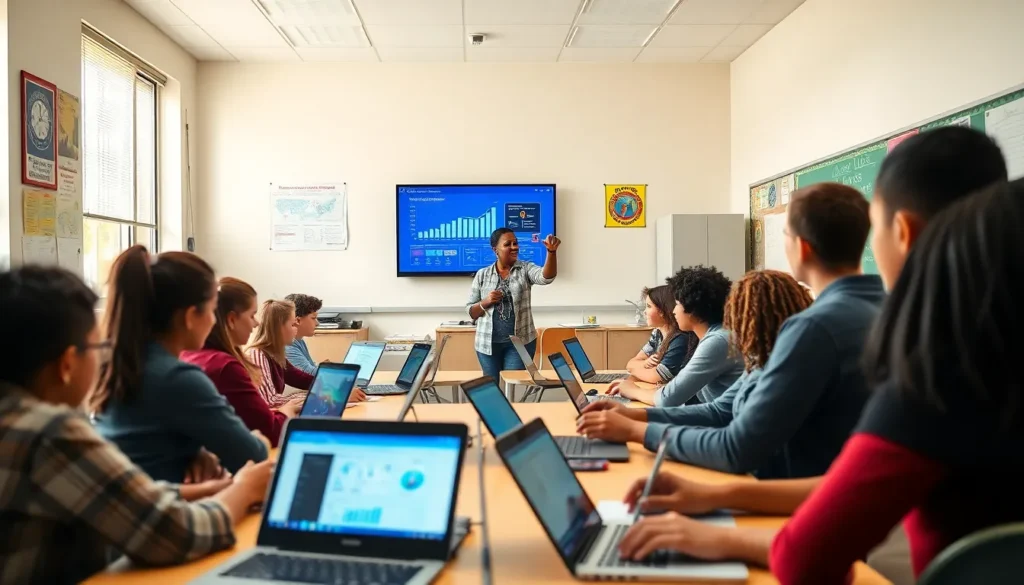In today’s fast-paced digital world, being tech-savvy isn’t just a perk—it’s a necessity. Imagine trying to navigate life without knowing how to send an email or Google something. It’s like trying to find a needle in a haystack while blindfolded. Digital literacy empowers individuals to confidently tackle online challenges, from job hunting to social networking, ensuring they don’t get lost in the digital wilderness.
Table of Contents
ToggleUnderstanding Digital Literacy
Digital literacy involves the ability to locate, evaluate, and use digital information effectively. This skill set is vital for success in various aspects of life, especially in a technology-driven world.
Definition and Importance
Digital literacy refers to the competence in using digital tools and resources. It encompasses skills such as navigating the internet, evaluating online sources, and using software applications. Important for personal and professional growth, digital literacy enables individuals to engage with technology efficiently. In a job market that increasingly relies on digital communication, those who possess strong digital literacy skills stand out. They experience enhanced opportunities for career advancement and personal development. Digital literacy also promotes informed decision-making, protecting individuals from misinformation and cyber threats.
Key Components of Digital Literacy
Several key components make up digital literacy. First, information literacy involves finding and assessing information from various digital sources. Next, multimedia literacy encompasses the ability to analyze and create content across different formats, such as videos and podcasts. Furthermore, digital communication skills allow individuals to interact effectively through emails and social media. Additionally, digital safety includes understanding online privacy, security practices, and recognizing potential threats. These components work together to create a comprehensive skill set that empowers individuals in the digital age.
The Role of Digital Literacy in Education

Digital literacy plays a crucial role in modern education by enhancing both engagement and understanding. It equips students with essential skills to effectively navigate digital platforms, fostering an interactive atmosphere.
Enhancing Learning Experiences
Students benefit from digital literacy through various interactive tools. Platforms like educational apps and online resources optimize learning by allowing personalized study experiences. Teachers leverage multimedia resources to present complex topics more clearly. By integrating digital literacy, educators cultivate critical thinking skills, enabling students to assess information sources thoroughly. These capabilities contribute to increased academic performance and retention of knowledge.
Preparing Students for the Workforce
Preparation for the workforce hinges on fostering digital competency among students. Employers increasingly seek candidates adept at using technology, making digital literacy vital. Students equipped with skills in data analysis, software proficiency, and online communication become more competitive. Networking through social media platforms and online collaboration tools also enhances student readiness. Mastering these digital tools ultimately leads to greater career opportunities and professional success.
Digital Literacy in Everyday Life
Digital literacy plays an essential role in daily routines. Individuals rely on digital skills for effective communication, information retrieval, and social interaction.
Impact on Communication and Social Interactions
Digital tools enhance communication efficiency. People use emails and messaging apps to connect more quickly than traditional methods. Social media platforms allow users to share updates and engage with communities. Mastering these tools fosters relationships and increases participation in discussions. Understanding online etiquette forms the foundation of respectful digital interactions. It also helps maintain privacy and security while communicating.
Navigating Information and Media
Individuals encounter vast amounts of information daily. Digital literacy equips users to discern credible sources from unreliable ones. Recognizing how to evaluate content’s authenticity builds trust in shared material. Workshops and online courses teach skills for effective research techniques. Awareness of media bias and misinformation shapes informed opinions. Navigating data critically empowers people to make sound decisions based on accurately interpreted information.
Challenges and Barriers to Digital Literacy
Digital literacy faces various challenges that hinder individuals from developing necessary skills. Factors such as socioeconomic status and access to technology significantly impact one’s ability to achieve digital proficiency.
Socioeconomic Factors
Low income often correlates with limited access to educational resources. Families with fewer financial means may struggle to afford devices or internet services. This lack of investment restricts opportunities for skill development. Educational environments in low-income areas frequently lack essential technology resources. Limited exposure leads to decreased familiarity with digital tools. In turn, individuals from lower socioeconomic backgrounds may find it difficult to compete in a technologically driven job market.
Access to Technology
Unequal access to technology creates significant barriers to digital literacy. Rural areas often face challenges related to internet connectivity. Many people in these regions lack reliable access to high-speed internet. Urban residents might experience different issues, such as overcrowded public Wi-Fi areas. Individuals who cannot afford personal devices are at a distinct disadvantage. Without consistent access, continuous skill improvement becomes nearly impossible. Additionally, schools in underprivileged areas might not provide adequate technology resources. This situation further perpetuates the cycle of digital illiteracy.
Strategies to Improve Digital Literacy
Improving digital literacy involves various strategies that empower individuals to navigate the digital landscape confidently.
Community Programs and Initiatives
Community programs often provide essential resources for enhancing digital skills. Libraries host free workshops, offering hands-on training for individuals of all ages. Nonprofits frequently collaborate with local organizations to create initiatives focused on technology education, addressing gaps in knowledge. Schools might also establish after-school programs to teach digital skills, targeting students who face barriers at home. Access to these programs can transform the lives of attendees, fostering confidence and competence in using digital tools.
Resources for Self-Improvement
Self-improvement resources play a pivotal role in enhancing digital literacy. Online courses from platforms like Coursera and edX cover a wide range of topics, enabling learners to progress at their own pace. YouTube tutorials often provide visual demonstrations, making complex concepts more accessible. E-books and articles from reputable sources equip individuals with the latest information on technology trends. Engaging with these resources creates opportunities for personal and professional development, building crucial skills needed in today’s job market.
Digital literacy is no longer optional; it’s a necessity for thriving in today’s world. As technology continues to evolve, the ability to effectively navigate digital landscapes becomes crucial for personal and professional success. Individuals equipped with digital skills can confidently tackle challenges and seize opportunities that arise in various aspects of life.
Moreover, fostering digital literacy not only enhances individual capabilities but also contributes to a more informed and engaged society. By addressing barriers to access and promoting educational initiatives, communities can empower everyone to develop these essential skills. Embracing digital literacy is a step toward a more equitable future where everyone can participate fully in the digital age.









